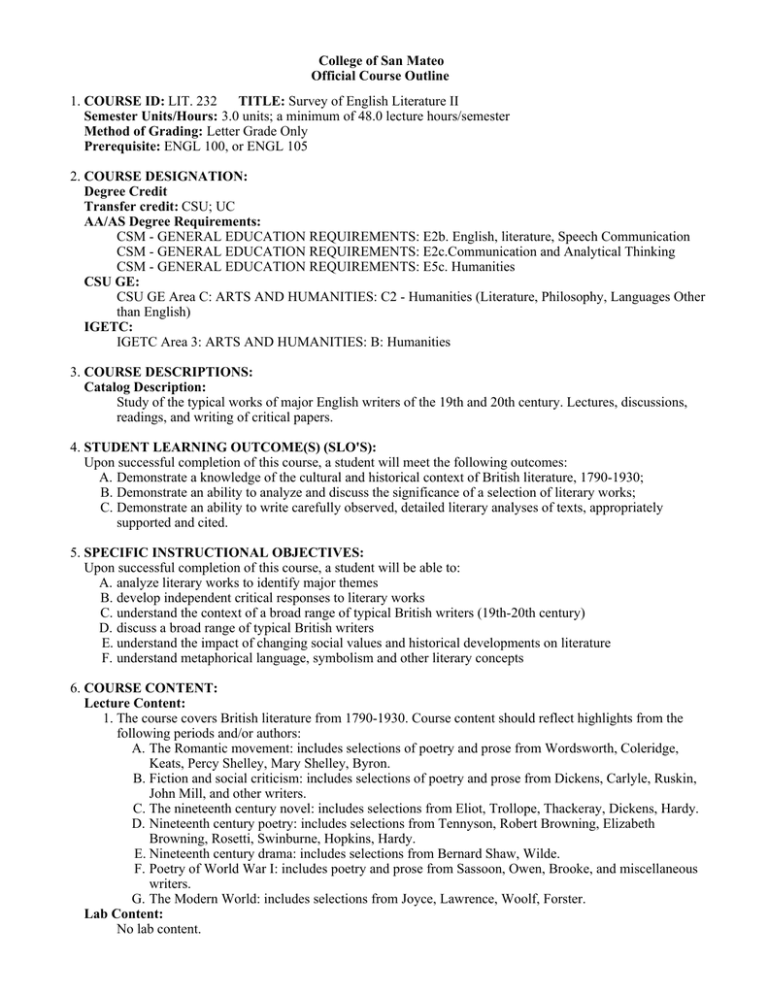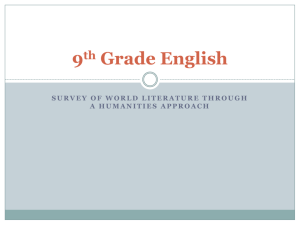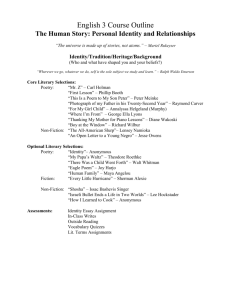College of San Mateo Official Course Outline COURSE ID: Semester Units/Hours:
advertisement

College of San Mateo Official Course Outline 1. COURSE ID: LIT. 232 TITLE: Survey of English Literature II Semester Units/Hours: 3.0 units; a minimum of 48.0 lecture hours/semester Method of Grading: Letter Grade Only Prerequisite: ENGL 100, or ENGL 105 2. COURSE DESIGNATION: Degree Credit Transfer credit: CSU; UC AA/AS Degree Requirements: CSM - GENERAL EDUCATION REQUIREMENTS: E2b. English, literature, Speech Communication CSM - GENERAL EDUCATION REQUIREMENTS: E2c.Communication and Analytical Thinking CSM - GENERAL EDUCATION REQUIREMENTS: E5c. Humanities CSU GE: CSU GE Area C: ARTS AND HUMANITIES: C2 - Humanities (Literature, Philosophy, Languages Other than English) IGETC: IGETC Area 3: ARTS AND HUMANITIES: B: Humanities 3. COURSE DESCRIPTIONS: Catalog Description: Study of the typical works of major English writers of the 19th and 20th century. Lectures, discussions, readings, and writing of critical papers. 4. STUDENT LEARNING OUTCOME(S) (SLO'S): Upon successful completion of this course, a student will meet the following outcomes: A. Demonstrate a knowledge of the cultural and historical context of British literature, 1790-1930; B. Demonstrate an ability to analyze and discuss the significance of a selection of literary works; C. Demonstrate an ability to write carefully observed, detailed literary analyses of texts, appropriately supported and cited. 5. SPECIFIC INSTRUCTIONAL OBJECTIVES: Upon successful completion of this course, a student will be able to: A. analyze literary works to identify major themes B. develop independent critical responses to literary works C. understand the context of a broad range of typical British writers (19th-20th century) D. discuss a broad range of typical British writers E. understand the impact of changing social values and historical developments on literature F. understand metaphorical language, symbolism and other literary concepts 6. COURSE CONTENT: Lecture Content: 1. The course covers British literature from 1790-1930. Course content should reflect highlights from the following periods and/or authors: A. The Romantic movement: includes selections of poetry and prose from Wordsworth, Coleridge, Keats, Percy Shelley, Mary Shelley, Byron. B. Fiction and social criticism: includes selections of poetry and prose from Dickens, Carlyle, Ruskin, John Mill, and other writers. C. The nineteenth century novel: includes selections from Eliot, Trollope, Thackeray, Dickens, Hardy. D. Nineteenth century poetry: includes selections from Tennyson, Robert Browning, Elizabeth Browning, Rosetti, Swinburne, Hopkins, Hardy. E. Nineteenth century drama: includes selections from Bernard Shaw, Wilde. F. Poetry of World War I: includes poetry and prose from Sassoon, Owen, Brooke, and miscellaneous writers. G. The Modern World: includes selections from Joyce, Lawrence, Woolf, Forster. Lab Content: No lab content. TBA Hours Content: TBA Hours Content: No TBA content. 7. REPRESENTATIVE METHODS OF INSTRUCTION: Typical methods of instruction may include: A. Lecture B. Critique C. Discussion D. Other (Specify): - Lectures: instructor gives an oral presentation to introduce students to a new work, historical concept, or author. - Guided readings: Students read and interpret specific works with instructor guidance. - Journal work: Students write journal entries in response to specific questions on the text. Student discussions: Student-led oral discussions based on journal readings; structured small- and large-group interaction. - Dramatic presentations: Attend recorded readings / dramatizations of appropriate material. - Collaborative / individual projects: Student-led projects into coursework or course-related material (research, presentations etc.). 8. REPRESENTATIVE ASSIGNMENTS Representative assignments in this course may include, but are not limited to the following: Writing Assignments: Journal work: Students write journal entries in response to specific questions on the text. Essays: Students write essays analyzing and discussing literary works. Reading Assignments: Guided readings: Students read and interpret specific works with instructor guidance. Other Outside Assignments: Dramatic presentations: Attend recorded readings / dramatizations of appropriate material. Collaborative / individual projects: Student-led projects into coursework or course-related material (research, presentations etc.). 9. REPRESENTATIVE METHODS OF EVALUATION Representative methods of evaluation may include: A. Class Participation B. Class Work C. Exams/Tests D. Group Projects E. Home Work F. Oral Presentation G. Papers H. Portfolios I. Projects J. Research Projects K. Written examination L. - Essays. Critical essays to demonstrate completion and understanding of material and independent response (totalling at least 4000 words over the semester). - Oral presentations. Active participation in class discussions to demonstrate understanding of material and independent response. - Journals. Written responses to assigned readings to demonstrate completion and understanding of material and independent response. - Final exam. Students may be asked to write an essay, make a presentation, or otherwise demonstrate their mastery of the course objectives. 10. REPRESENTATIVE TEXT(S): Possible textbooks include: A. Greenblatt, Steven; Christ, Carol T.; David, Alfred; Lewalski, Barbara K.. The Norton Anthology of English Literature, Vol. 2, 9th ed. New York: W. W. Norton, 2012 Origination Date: August 2010 Curriculum Committee Approval Date: April 2013 Effective Term: Fall 2013 Course Originator: Madeleine Murphy



